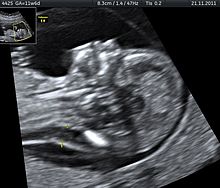User:Mr. Ibrahem/Stillbirth
| Stillbirth | |
|---|---|
| Other names | Fetal death, fetal demise[1] |
 | |
| Ultrasound is often used to diagnose stillbirth and medical conditions that raise the risk. | |
| Specialty | Obstetrics |
| Symptoms | Fetal death at or after 20 / 28 weeks of pregnancy[1][2] |
| Causes | Often unknown, pregnancy complications[1][2][3] |
| Risk factors | Mother's age over 35, smoking, drug use, use of assisted reproductive technology, first pregancy[4] |
| Diagnostic method | No fetal movement felt, ultrasound[5] |
| Treatment | Induction of labor, dilation and evacuation[6] |
| Frequency | 2.6 million (1 for every 45 births)[2] |
Stillbirth is typically defined as fetal death at or after 20 or 28 weeks of pregnancy, depending on the source.[1][2] It results in a baby born without signs of life.[2] A stillbirth can result in the feeling of guilt or grief in the mother.[7] The term is in contrast to miscarriage, which is an early pregnancy loss, and live birth, where the baby is born alive, even if it dies shortly after.[7]
Often the cause is unknown.[1] Causes may include pregnancy complications such as pre-eclampsia and birth complications, problems with the placenta or umbilical cord, birth defects, infections such as malaria and syphilis, and poor health in the mother.[2][3][8] Risk factors include a mother's age over 35, smoking, drug use, use of assisted reproductive technology, and first pregnancy.[4] Stillbirth may be suspected when no fetal movement is felt.[5] Confirmation is by ultrasound.[5]
Worldwide prevention of most stillbirths is possible with improved health systems.[2][9] About half of stillbirths occur during childbirth, with this being more common in the developing than developed world.[2] Otherwise, depending on how far along the pregnancy is, medications may be used to start labor or a type of surgery known as dilation and evacuation may be carried out.[6] Following a stillbirth, women are at higher risk of another one; however, most subsequent pregnancies do not have similar problems.[10] Depression, financial loss, and family breakdown are known complications.[9]
Worldwide in 2015 there were about 2.6 million stillbirths that occurred after 28 weeks of pregnancy (about 1 for every 45 births).[2][11] They occur most commonly in the developing world, particularly South Asia and Sub-Saharan Africa.[2] In the United States for every 167 births there is one stillbirth.[11] Stillbirth rates have declined, though more slowly since the 2000s.[12]
References[edit]
- ^ a b c d e "Stillbirth: Overview". NICHD. 23 September 2014. Archived from the original on 5 October 2016. Retrieved 4 October 2016.
- ^ a b c d e f g h i j "Stillbirths". World Health Organization. Archived from the original on 2016-10-02. Retrieved 2016-09-29.
- ^ a b "What are possible causes of stillbirth?". NICHD. 23 September 2014. Archived from the original on 5 October 2016. Retrieved 4 October 2016.
- ^ a b "What are the risk factors for stillbirth?". NICHD. 23 September 2014. Archived from the original on 5 October 2016. Retrieved 4 October 2016.
- ^ a b c "How is stillbirth diagnosed?". NICHD. 23 September 2014. Archived from the original on 5 October 2016. Retrieved 4 October 2016.
- ^ a b "How do health care providers manage stillbirth?". NICHD. 23 September 2014. Archived from the original on 5 October 2016. Retrieved 4 October 2016.
- ^ a b Robinson, GE (January 2014). "Pregnancy loss". Best Practice & Research. Clinical Obstetrics & Gynaecology. 28 (1): 169–78. doi:10.1016/j.bpobgyn.2013.08.012. PMID 24047642.
- ^ Lawn, Joy E; Blencowe, Hannah; Waiswa, Peter; Amouzou, Agbessi; Mathers, Colin; Hogan, Dan; Flenady, Vicki; Frøen, J Frederik; Qureshi, Zeshan U; Calderwood, Claire; Shiekh, Suhail; Jassir, Fiorella Bianchi; You, Danzhen; McClure, Elizabeth M; Mathai, Matthews; Cousens, Simon (2016). "Stillbirths: rates, risk factors, and acceleration towards 2030". The Lancet. 387 (10018): 587–603. doi:10.1016/S0140-6736(15)00837-5. ISSN 0140-6736. PMID 26794078.
- ^ a b "Ending preventable stillbirths An Executive Summary for The Lancet's Series" (PDF). The Lancet. Jan 2016. Archived (PDF) from the original on 2018-07-12. Retrieved 2016-10-04.
- ^ "Stillbirth: Other FAQs". NICHD. 23 September 2014. Archived from the original on 5 October 2016. Retrieved 4 October 2016.
- ^ a b "How common is stillbirth?". NICHD. 23 September 2014. Archived from the original on 5 October 2016. Retrieved 4 October 2016.
- ^ Draper, Elizabeth S.; Manktelow, Bradley N.; Smith, Lucy; Rubayet, Sayed; Hirst, Jane; Neuman, Melissa; King, Carina; Osrin, David; Prost, Audrey (2016-02-06). "Stillbirths: rates, risk factors, and acceleration towards 2030". The Lancet. 387 (10018): 587–603. doi:10.1016/S0140-6736(15)00837-5. ISSN 0140-6736. PMID 26794078. Archived from the original on 2021-08-28. Retrieved 2019-08-02.
